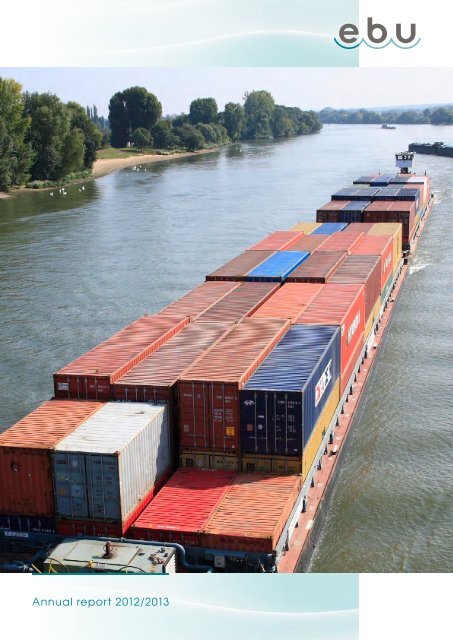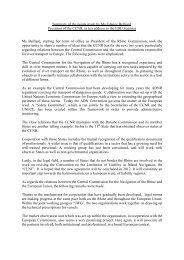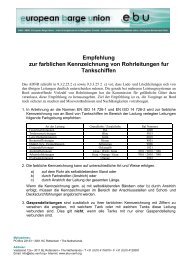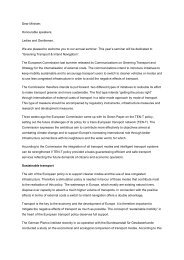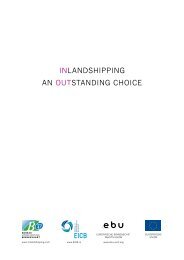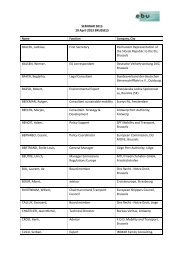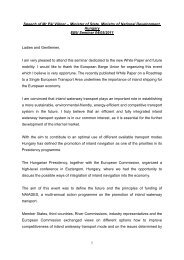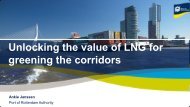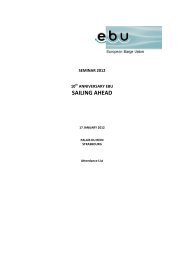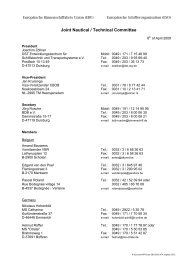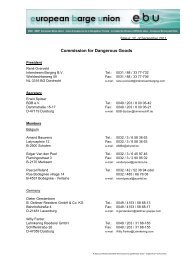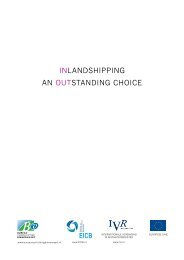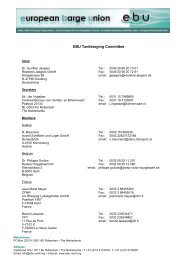Annual report 2012/2013 - EBU
Annual report 2012/2013 - EBU
Annual report 2012/2013 - EBU
- No tags were found...
Create successful ePaper yourself
Turn your PDF publications into a flip-book with our unique Google optimized e-Paper software.
ContentIntroduction: Challenges ahead 5IWT Policy 6New Ten-T Policy 8Special <strong>report</strong>s 11LNG - most promising future developmentContainerisation – challenging developmentsPassenger transport –enormous potential<strong>EBU</strong> activities 14The Association / <strong>EBU</strong> Members 15Structure (as per april <strong>2013</strong>) 20annual <strong>report</strong> <strong>2012</strong>/<strong>2013</strong>2 3
New Ten-TPolicyINLAND WATERWAYS – A VITAL PARTOF THE CORE NETWORKMoreover, whilst the transport budgetproposal looks ambitious at a first glance,aside for the Trans-European TransportNetworks (TEN-T) in the 2007-<strong>2013</strong> period,The Seine-Nord Europe project is one ofwill replace the Canal de Saint-Quentinand the current Canal du Nord, increas-<strong>EBU</strong>, together with numerous European transport organisations, urged EUMember States and the European Parliament to safeguard the 32 billionEUR budget that has been allocated to EU transport infrastructure withinthe Connecting Europe Facility (CEF) in the 2014-2020 budget. Achievinga complete and integrated resource-efficient and sustainable transportnetwork, covering and interconnecting all modes, Member States andRegions must be seen as essential investments to create growth and jobsin the European Union.it actually compensates important cutson the side of the regional funds. Thereare clear indications that transport fundsfrom the European Regional DevelopmentFund (ERDF), which represented 46.7 billionEUR for the 2007-<strong>2013</strong> period, will begreatly reduced and, in some regions, evencompletely removed by the new ERDFregulation. In this context, the 32 billionan amount which Member States havefully taken up according to the latest Commissiondata. But at the same time, thesubstantial cut of the budget comparedto the initial 32 billion will seriously affectthe implementation of the transportinfrastructure plan the Commission hasbeen developing over the last three years,in close co-operation with Member Statesthe priorities listed on the actual TEN-Tlist. The 105-kilometre-long canal willconnect the Seine and Scheldt rivers andfacilitate the transport of goods throughinland waterways. When the new SeineNord connection is ready, it will allowlarge vessels to transport goods betweenthe Seine river (and the Paris area) and theports of Dunkerque, Antwerp, and Rot-ing maximum barge capacity from 650 to4400 tonnes.In the last year the French governmentannounced an assessment of all majorinfrastructure projects among which theSeine-Nord canal. Although the projecthas meanwhile been selected by theFrench government as a key project apartfrom the long list of other projects itsEUR (or around 3% of the total Multiannu-and stakeholders.terdam, or further into Europe. The canalfinancing needs to be guaranteed.The transport industry directly employsaround 10 million people in the EU andaccounts for about 5% of the GDP. Whenrelated industries (manufacturing,al Financial Framework) allocated to theTrans-European transport core infrastructurein 2014-2020 is a vital minimum andmust be guaranteed more than ever.In a first common reaction to thisresult, European transport organisationsexpressed their satisfaction thatthe transport infrastructure envelope<strong>EBU</strong> called upon the responsible French Ministers to ask for anincrease of EU-co-financing as it considers this project of highadded value for the development of the European economy.servicing, maintenance, etc.) are included,Notwithstanding the budgetary con-has increased, compared to the currentthese figures can be doubled. Besides,straints all governments are facing at themulti-annual budget. It is considered atransport is one of the sectors in whichmoment, it is well known that transportmissed opportunity for European leadersEuropean companies are world leaders ininfrastructure investments pay off into cut a growth-stimulating sector. Ifinfrastructure, logistics, traffic manage-the long run.people and goods cannot move efficiently,ment systems and manufacturing oftransport equipment.The European transport industryFirst reaction of EuropeanTransport Sector to the EUbudget deal: a “yes, but...”growth and economic development areconstrained. Transport therefore deservesmore than a mere 2.4% share of the totalbudget.expressed its concerns that not enoughOn 8 February <strong>2012</strong> European leadersPending the agreement between thefunds will be available to cover invest-reached an agreement on the EU budgetEuropean Parliament and the Council <strong>EBU</strong>ment needs. The 32 billion EUR, earmarkedfor the next seven years. With a cut of onepromotes a strong role for inland water-by the European Commission to the Corethird in the 32 billion EUR initially fore-ways within this concept.Network in the Connecting Europeseen for transport infrastructure projects,Facility only covers a small share oftransport does not appear to be consideredthe investment needs.a priority sector in the next budget.However, the resulting budget of 23 billionEUR is a significant step forward comparedto the 8 billion EUR that was setannual <strong>report</strong> <strong>2012</strong>/<strong>2013</strong>8 9
SpecialReportsDanube – Straubing Vilshofen:wrong decision by BavariangovernmentAs second largest river in Europe the Danuberiver offers huge potential for a modalshift and development of the EasternEuropean economy.On 23 February <strong>2013</strong> the Bavarian governmenthowever took the decision not tosolve the major bottlenecks on this riverFast Facts The Danube Basinat the Straubing Vilshofen stretch.In the past three years a monitoring groupassessed the different options that whereat discussion. One of <strong>EBU</strong>’s board memberscontributed to the works of this monitoringgroup which was intended to feed intothe decision process.<strong>EBU</strong> strongly criticizes and highly regretsthe decision by the Bavarian Ministrywhich in its motivation hardly takes Second largest river in Europe (aer the Volga), flowing more than 2,800 km from Bavaria’s Black Forest in Southern Germany to its delta on the Black Sea in Romania Directly linked to the Rhine and North Western Europe by the Rhine-‐Main-‐Danube Canal, opened in 1992 notice of the long lasting assessment andits outcome. The decision taken does notsolve the existing problem of insufficientdraught in the river, for which sustainableand environmentally protecting solutionshave been proposed as outcome of themonitoring process.The solution which has been taken willnot be supported by European TEN-Tfunds as it is not supporting the developmentof the waterway. Drains 10% of the enre European connent, covering all or part of 18 countries Serves a region of 100 million people Spanned by 126 bridges Source: PLATINA (<strong>2012</strong>)LNG - MOST PROMISINGFUTURE DEVELOPMENTDuring the last years the development ofLNG (Liquefied Natural Gas) has taken off.The support of single projects which willuse LNG has shifted towards standarisationof legislature concerning this type of fuelas well as the introduction of a new dimension,being the possible authorization toship LNG as cargo in type G (Gas) tankers.A broad scope of activities has been identifiedand is being addressed in numerouscommissions. The potential and expectationsof LNG as regards environmental andeconomic impact of the sector are high.With the operational deployment of tankvessel Argonon a live test case has assistedin the future development of more vesselsthat can be equipped with this type of enginefor the coming generation of inlandvessels. Since then 3 other tank vesselshave meanwhile been given permissionto be operated and sail on LNG. These permissionshad to be obtained for differentregulations regarding fueling activitiesand company regulations which are applicablefor terminals. This broad approachfor obtaining the necessary permissionshas asked tremendous efforts of directstakeholders. Another 5 vessels, includingpassenger, dry cargo and push bargeconcepts, are expected to ask for specialpermissions shortly. <strong>EBU</strong> calls upon thecompetent regulators to shortly introduceregular standards for these vessels.To assess the risks of sailing on LNG andcarrying LNG as cargo the Dutch Organizationfor Applied Scientific Research evaluatedthe HAZID (Hazard Identification)studies of the proposed projects as regardscollision calculations, the crashworthinessof the cryogenic tank, submitted CFDcalculations, scenario’s which take intoaccount an LNG spill on deck, the influenceof fire, etc.Also training requirements have beenaddressed leading to a standardised trainingrequirement to be introduced in therelevant regulations in due course. <strong>EBU</strong>’sDangerous Goods Committee assisted aworking group at UNECE level to authorizethe transport of LNG as bulk cargo.Inland waterway transport, due to its high safety standardand its other characteristics, is predestinated to carry highvolumes of LNG as cargo. <strong>EBU</strong> calls upon the competentauthorities to shortly introduce regular standards for sailingon LNG and carrying LNG as cargo.annual <strong>report</strong> <strong>2012</strong>/<strong>2013</strong>10 11
SpecialReportsCONTAINERISATION- CHALLENGINGDEVELOPMENTSAs a result, in <strong>2012</strong> many shippers shiftedtheir goods from road to inland waterway.issue once and for all. Under the name“Nextlogic”, a project was initiated bythe inland container shipping industry,PASSENGER TRANSPORT –ENORMOUS POTENTIALHowever, reliability of the total trans-financed by the Port of Rotterdam andAlthough the passenger transport seg-One of the segments in the inland ship-port chain is key to the success of inlandthe Dutch Transport Ministery, aimed atment was hit much later by the economicping industry that has extensively been incontainer shipping. Unfortunately, itsconsolidation of small container volumes,crisis than the freight transport segment,the picture during the last few years is thetraditional reliability suffered severelyinformation exchange, performanceduring <strong>2012</strong> we witnessed an increasinginland container shipping industry. Theby the serious congestion on deepseamonitoring, and dynamic planning.number of passenger shipping compa-developments with regard to the Secondterminals in the sea ports of RotterdamA unique feature of this initiative is, thatnies being confronted by a considerableMaasvlakte (“Maasvlakte 2”) in the Port(and Antwerp).it is the first of its kind to include all rel-decrease in turnover.of Rotterdam, the obligation the Port ofevant stakeholders. More than 25 marketRotterdam imposed on its customers toTherefore, in <strong>2012</strong> the inland containerparties are actively involved. In the courseNotwithstanding the economic dip, thehave 45% of all hinterland container trans-shipping industry continued its seriousof <strong>2013</strong> a new tool for dynamic planning,potential of waterways for passengerport carried out by inland waterways,efforts, together with all relevant stake-the so called “brain”, will be launched,transport remains enormous. Passengerand the green image of inland waterwayholders such as deepsea shipping lines,causing a real system leap into a totallytransport on the European inland water-transport, all constitute a great incentivedeepsea terminals, empty depots, anddifferent way of planning terminal slotsways not only plays an important role into the inland waterway container market.inland terminals, to solve this toughand barges.the wide range of touristic and leisure services,with various sightseeing, day tripand river cruise ships, but also in respectto (regional) mobility, with several ferryTransitional provisionsPassenger Rightsservices providing swift, efficient andAs in the freight transport segment, someFrom 18.12.<strong>2012</strong> Passenger Rights are ap-reliable mobility to numerous commuters.of the transitional provisions with regardplicable also for the cruise ships on inlandWaste treaty:discharge of waste waterto technical regulations that will end after2015, will cause serious technical andfinancial issues to the passenger shippingwaterways. First experience shows thatmost of the regulations are adjusted forscheduled and time-tabled services. SomeOn 31st December 2011 the ban onindustry. The transitional provision thatof them are not appropriate to the situa-overboard discharge of waste water foris likely to have a massive impact is thetion in the cruise industry or have to bepassenger ships entered into force. Anone on the regulation with regard to theinterpreted more distintinctive for theincreasing number of passenger shippingsecond, independent engine room, wherecruise business.companies have during <strong>2012</strong> been able tothe costs involved are in no relation to therealize proper discharge facilities ashore.potential safety benefits. At the end ofHowever, there is still no clarity with<strong>2012</strong> work on this issue started; it will beregard to the technical specifications forcontinued in <strong>2013</strong>.water treatment plants and adequatetransitional provisions for existing watertreatment plants.annual <strong>report</strong> <strong>2012</strong>/<strong>2013</strong>12 13
<strong>EBU</strong>activitiesThe Association<strong>EBU</strong> MembersChange of presidencySafetyOn 13 February <strong>2013</strong> <strong>EBU</strong>’s Board of Directorselected the president of the CzechAfter some incidents on German waterwayswith smouldering coal in <strong>2012</strong>, <strong>EBU</strong>AustriaBelgiumbarge owners association, Lubomir Fojtu,presented a proposal to amend the ADN.as its new President and Didier Leandri,This proposal has been coordinated withBerufsgruppe Schifffahrt / Wirtschaftskammer ÖsterreichUnie der Continentale Vaart v.z.w.representative of the French Bargethe coal importing industry. Due to <strong>EBU</strong>’sWiedner Hauptstr. 63Kleindokkai 3-5Association CAF, as Vice President. Underproposal the transportation of coal has1040 WienB-9000 GENTits newly elected President <strong>EBU</strong> will focusnot to comply with the ADN regulationson the continuation of NAIADES II andthe priorities to support inland water-Seminar “Greening the corridors”as long as• the loading temperature is belowUCV is an association of Shipowners (companies) and FreightForwarders, in charge of the interests of the members in allway transport within the European andTo emphasise the importance of this topic60 ° Celsiusmatters of inland waterway transport, representing thenational transport policies.<strong>EBU</strong> will dedicate its annual seminar on• the journey is not longer than 20 daysmembers in Belgium and Europe at all levels.10 April <strong>2013</strong> to the greening of the corri-• the crew gets an instruction list how toUCV is also a representative association of employersdors. The green vessel which already sailsact in case of heatingThe „Berufsgruppe Schifffahrt“ is the legal representation ofrecognized by the Belgian government.on low sulphur since a couple of years willIf the journey lasts longer than 20 daysmore than 450 members with a total fleet of some 100 vessels.UCV is a founding member of the European Barge Unionsteadily move towards alternative fuelsthe temperature of the coal has to beIt is located in Vienna and part of the Austrian Chamber ofsuch as LNG in the next years. Vessels willmonitored.Commerce. The members represent all market segments ofAlgemeen Aktiecomité der Belgischesupply industry with green energy oninland navigation.Binnenscheepvaartorganisatiesgreen corridors. While legislation is stillThese elements are expected to be cov-Dokseinde 14lacking behind practice, the first inlandered by a multilateral agreement for theIts aim is to keep and improve the market and competitiveB-2930 BRASSCHAATvessels are sailing on LNG and are await-transportation of coal which shall be validposition of the Austrian inland navigation industry. Moreo-ing a broad distribution infrastructureuntil the 31st of December 2014. After thatver it is aimed at integrating inland navigation into modernAssociation de Maitres Bateliers des Regions de Liege,along the waterway corridors. At this oc-a regular amendment of the ADN 2015logistic chains and to accelerate the intermodal developmentLimbourg et Charleroicasion Vice President and Commissionerwill follow.of the Austrian ports.24, Quai de Coronmeusefor Transport Siim KALLAS will onceB-4000 LIEGEagain deliver a key note speech.Berufsgruppe Schifffahrt/Wirtschaftskammer Österreich isCCNR and UNECE Working groupsa founding member of the European Barge Union.A.M.B. was officially founded on 7 February 1927.It is an association recognized by the Belgian and Walloon<strong>EBU</strong> participated at several meetings ofauthorities where it is duly represented in several commit-the Central Commission for the Naviga-tees, institutions and organizations. Its aim is the promotion,tion on the Rhine (CCNR) and the UNECEprotection and defense of all navigational and professionalsto defend the industry’s position at work-interests of its members.ing group and plenary level. It a.o. repeat-The members are mostly single barge owners, registerededly voiced the concern of the industrymostly in the southern part of Belgium. Some are owners ofregarding the decrease of the guaranteedmore than one vessel.depth of locks in France.A.M.B. is a founding member of the European Barge Unionannual <strong>report</strong> <strong>2012</strong>/<strong>2013</strong>14 15
The Association<strong>EBU</strong> MembersCzech RepublicFranceGermanyLuxembourgAVP-CZ Czech Barge UnionComité des Armateurs Fluviaux (CAF)Bundesverband der Deutschen Binnenschiffahrt e.v. (BDB)Fedil - Business Federation LuxembourgK. Capka 211/18, rue Saint FlorentinDammstrasse 15-177, rue Alcide de GasperiCZ-40591 DECIN 1D-75001 PARISD-47119 DUISBURGLuxembourg-KirchbergBundesverband der DeutschenBinnenschiffahrt e.V. (BDB)The Czech River-Barge Union was established in 2003 andThe Comité des Armateurs Fluviaux (CAF) is the professionalThe German Association of Inland Navigation, founded inFounded in 1918, Fedil – Business Federation Luxembourg isrepresents ca 95 % of the Czech river fleet. The mission of therepresentation of the French inland navigation enterprises as1974, is a national professional organisation representing thetoday a multisectoral business federation representing the in-Association is to establish the conditions for the developmentwell as the sectors that are linked with the inland navigationmajority of the German inland navigation fleet. It was formeddustry, construction and business services sectors. As regardsof inland navigation in the Czech Republic, to represent, for-industry. Today some eighty enterprises represent the indus-by the merger of regional associations. BDB is headquarteredthe Luxembourg economy, the Fedil member companies rep-mulate, support and promote justified and common intereststry in the following way:in Duisburg, (a few steps from) Europe´s most important in-resent 25% of added value, 30% of domestic employment and 8of its members with the goal to support inland navigation.land port. In addition, a permanent representation is locatedbillion EUR per year in exports. At national level, Fedil’s main• Nearly the total of the inland shipping companies, a con-in Berlin which enables an active substantial exchange onobjective is to defend the professional interests of its memberssortium of single barge owners and some small fleets fornational infrastructure and industrial policy with the minis-and analyse all economic, social and industrial issues relatingthe sector of industrial transport. These enterprises realizetries and other stakeholders.thereto. Furthermore, Fedil endeavours to develop the spiritsome 40 % of the inland traffic in ton-kilometers on theBDB´s members come from all market segments of cargo andand links of solidarity between Luxembourg employers.national waterways. They are also active internationally.passenger shipping. BDB is the sole national organisation thatrepresents both shipping companies and owner operators.At Community level, Fedil is affiliated to BUSINESSEUROPE• Some forty enterprises of the Inland Waterway Tourismand has a representative office in Brussels. As an organisa-sector who offer tours and cruises with overnight stay toBDB´s objective is to strengthen the competitive position oftion representing Luxembourg employers, it participates inFrench and foreign passengers in all the regions of Franceinland barge operators and to represent their interests. Forthe activities of the International Labour Conference (ILO) inon rivers or lakes with a great range of possibilities.this reason the association pursues activities on national andGeneva. It is also a member of the International Organisationinternational level. It actively supports issues of the industryof Employers (IOE) and the Business and Industry AdvisoryCAF is a founding member of the European Barge Union.in various fields such as infrastructure, fiscal and legal policyCommittee to the OECD (BIAC).or nautical and technical conditions of vessel operation.BDB is a founding member of the European Barge Union.annual <strong>report</strong> <strong>2012</strong>/<strong>2013</strong>16 17
The Association<strong>EBU</strong> MembersNetherlandsSwitzerlandRomaniaCentral Bureau for inland Barging (CBRB)Vasteland 12 E3011 BL ROTTERDAMSchweizerische Vereinigung für Schifffahrtund Hafenwirtschaft (SVS)Südquaistrasse 14CH-4019 BASELRomanian Association of Inland Ship Ownersand Port Operators (AAOPFR)St. Albatrosului 2,RO-800029 GALATiThe Central Bureau for Inland Barging (CBRB) is an employers’organisation for companies operating on the river Rhine andother inland waterways. It represents the interests of its (400)members in national and international organisations andgovernments, and participates in the various consultationplatforms in the world of business.The Bureau takes an interest in the fields of transport policy,labour issues, legal matters, the environment and nautical affairs.Its members are drawn from inland transport enterprisesfrom all market segments – from the tanker and dry-cargoindustries to container and roll-on-roll-off transport, fromtowage and push-towing to passenger transportation.CBRB is a founding member of the European Barge Union.The Swiss Association of inland navigation and ports (SVS)represents the interests of the inland navigation industryand its stakeholders towards authorities and other associations.The association is a member of various national andinternational organisations and holds the secretariat of the‘Inland Navigation’ parliamentary group. By the end of 2011SVS counted some 255 members in the categories individualmembers (120), companies (74), partners of the inland navigation(32) as well as authorities, associations and organisations(29). The SVS is directed by a Board consisting of ten members.The director is responsible for the daily business.SVS is a founding member of the European Barge Union.Founded in April 1993, the “Romanian Association of InlandShip Owners and Port Operators” represents almost 90% ofthe Romanian inland navigation fleet capacity and 90% ofthe Romanian inland port operators.The original name was “Romanian Association of Inland ShipOwners”, but the membership was extended to include portoperators, shipping companies, brokers, insurance companiesetc that are acting in the Romanian inland navigation field.AAOPFR has its head office in Galati, the biggest inland portin Romania, hosting the largest inland navigation fleet. Themembers of the Board of Directors are usually elected in sucha manner that a large area of Romanian inland navigationwaterways and ports (Galati, Braila, Constanta, Drobeta-Turnu Severin etc) is covered.The main objective of the association is to promote, nationallyand internationally, the interest of their members.AAOPFR has been an observer member of <strong>EBU</strong> since 2007 andin 2008 applied for full membership.annual <strong>report</strong> <strong>2012</strong>/<strong>2013</strong>18 19
Structure(as per april <strong>2013</strong>)<strong>EBU</strong>-OfficialsLuxembourgCzech RepublicSwitzerland• T. Hermes, Fedil-Business Federation Luxembourg, Luxem-• S. Tlustos, Ceskeprístavy, PrahaH. Amacker, Danser Switzerland AG, Basel• President, Lubomir Fojtu (CZ)• Vice-President, Didier Leandri (F)bourg• R. Tadsen, Imperial Shipping GmbH, WasserbilligFranceTANKBARGING COMMITTEE• Secretary General, Theresia Hacksteiner• H. Lacour, Chambre Nationale de la BatellerieChairBoard of DirectorsNetherlands• Ir. T. Muller, Centraal Bureau voor de Rijn- en Binnenvaart,Artisanale (CNBA), Paris• M. Leleu, Chambre Nationale de la Batellerie Artisanale• Dr. G. Jaegers, Reederei Jaegers GmbH, DuisburgRotterdam(CNBA), ParisSecretaryAustria• J. Vogelaar, Centraal Bureau voor de Rijn- en Binnenvaart,• J.-M. Meyer, Compagnie Française de la Navigation• R. Tieman, Centraal Bureau voor de Rijn- en Binnenvaart,• N. Baumann, Danu Transport GmbH, WienRotterdamRhénane, StrasbourgRotterdam• Mag. P. Blachnik, Berufsgruppe Schiffahrt, Wien,(alternate member)RomaniaGermanyAustria• Dipl. Ing. W. Mosser, Brandner Wasserbau GmbH, Wallsee• L. Cotiga, AAOPF, Galati• N. Hohenbild, MS ‘’Catharina”, Emmerich• N. Baumann, Avanti Schiffführt und Lager GmbH,• W. Schröder, Deutsche Binnenreederei AG, BerlinKorneuburgBelgiumSwitzerland• J. Zöllner, (vice-chair) DST, Duisburg• W. Pierre, De Grave Antverpia, Herstal ( A.M.B.)• A. Auderset, SVS, BaselBelgium• G. van Overloop, De Grave Antverpia, Antwerpen• B. Heydrich, Ultra-Brag AG, BaselNetherlands• Dr. Ph. Grulois, Unie der Continentale Vaart, Gent(alternate member)• Dr. Ph. Grulois, Unie der Continentale Vaart, GentCommittees• B.E. Boneschansker, ThyssenKrupp-Veerhaven B.V., Brielle• M. van Helvoirt, Centraal Bureau voor de Rijn- enFrance• M. Parmentier (alternate member), Aktiecomité-Comitéd’Action, AntwerpenNautical-Technical CommitteeBinnenvaart, Rotterdam• G. Kester, Binnenvaart Branche Unie, Rotterdam• J.-M. Meyer, Compagnie Française de la Navigation Rhénane,StrasbourgChair• J. Kruisinga, (chair) CBOB, Rotterdam• H. Thébaud, CFT, Le Havre CedexCzech Republic• J. Kruisinga, CBOB, Rotterdam• N. Lurkin, Centraal Bureau voor de Rijn- en Binnenvaart,• L. Fojtu (President), A.V.P-CZ, DecinRotterdamGermanyVice-Chair• L.M.E. Pater-de Groot, Centraal Bureau voor de Rijn- en• Dr. G. Jaegers, (chair) Reederei Jaegers GmbH, DuisburgFrance• J. Zöllner, DST, DuisburgBinnenvaart, Rotterdam• D. Leandri (Vice-President), Comité des Armateurs Fluviaux,• R. Tieman, Centraal Bureau voor de Rijn- en Binnenvaart,NetherlandsParisSecretaryRotterdam• C. De Graaf, Zwaans v.d. Heuvel Tankvaart B.V., Rotterdam• J. Rusche, Bundesverband der Deutschen Binnenschiffahrt• R. Overveld, Interstream Barging Europe B.V., DordrechtGermanye.V., DuisburgRomania• R. Versloot, Vof Commander, Zwijndrecht• Dr. G. Jaegers, Reederei Jaegers GmbH, Duisburg• S. Rodenau, CFNR Navrom, Galati• J. Schwanen, Bundesverband der Deutschen Binnenschif-BelgiumSwitzerlandfahrt e.V., Duisburg• J. van Duynslaeger, VBR, Edegem• R. van Westenbrugge, Schweiz. Ver. Für Schiffahrt &• M. Staats, MSG eG, Würzburg• D. Mertens, Unie der Continentale Vaart VZW, MechelenHafenwirtschaft, Basel• P. Roland, Association des Maîtres Bateliers, Bodegnée-Verlaineannual <strong>report</strong> <strong>2012</strong>/<strong>2013</strong>20 21
Structure(as per april <strong>2013</strong>)DANGEROUS GOODS COMMITTEENetherlandsGermanyFranceChair• R. Overveld, (chair) Interstream Barging Europe B.V.,• F. Heim, Köln-Düsseldorfer Deutsche Rheinschiffahrt AG,• D. Leandri, Comité des Armateurs Fluviaux, Paris• R. Overveld, Interstream Barging Europe B.V., DordrechtDordrechtKöln• F.M. Pruyn, (vice-chair) Wijgula-Wijnhoff & Van Gulpen• W. Thie, Neckar Personenschiffahrt Berta Eplle GmbH & Co.NetherlandsVice-Chair& Larsen B.V., DrutenKG, Stuttgart• M. Koning, (chair) Centraal Bureau voor de Rijn- en Binnen-• F.M. Pruyn, Wijgula-Wijnhoff & Van Gulpen & Larsen B.V.,• D. van Kempen, Chemgas B.V., Rotterdam• J. Rusche, Bundesverband der Deutschen Binnenschiffahrtvaart, RotterdamDruten• R. Tieman, Centraal Bureau voor de Rijn- en Binnenvaart,e.V., Duisburg• J. Naaborgh, Chemgas Shipping, RotterdamRotterdamSecretaryNetherlandsRomania• E. Spitzer, Bundesverband der Deutschen BinnenschiffahrtSwitzerland• M. van Helvoirt, Centraal Bureau voor de Rijn- en Binnen-• L. Cotiga, AAOPF, Galatie.V., Duisburg• G. Baumgartner, Stetrag AG, Basel• M. Maier, Stetrag AG, Baselvaart, RotterdamPUSHBARGING COMMITTEEBelgium• A. Bauwens, SchotenPASSENGER TRANSPORT COMMITTEESwitzerland• R. Reitsma, Scylla Tours AG, BaselChair• G. Hötte, Rhenus PartnerShip GmbH & Co. KG, Duisburg• D. Mertens, Unie der Continentale Vaart VZW, MechelenChair• W.B. de Zeeuw, (chair) De Zeeuw Reederei Management, Basel• P. Roland, Association des Maîtres Bateliers,Bodegnée-Verlaine• W.B. de Zeeuw, De Zeeuw Reederei Management, BaselSOCIAL COMMITTEESecretary• J. Vogelaar, Centraal Bureau voor de Rijn- en Binnenvaart,SecretaryChairRotterdamFrance• M. van Helvoirt, Centraal Bureau voor de Rijn- en• M. Koning, Centraal Bureau voor de Rijn- en Binnenvaart,• J.H. Meyer, Compagnie Française de Navigation Rhénane,Binnenvaart, RotterdamRotterdamFranceStrasbourg• B. Grosjean, Compagnie Fluviale de Transport, Le Havre• G. Piechowski, Compagnie Fluviale de Transport, Le HavreAustriaAustria• N. Rousseau, Compagnie Fluviale de Transport, Le Havre• W. Hanreich, DDSG GmbH, Wien• P. Blachnik, WKO, WienGermany• G. Hötte, (chair) Rhenus PartnerShip GmbH & Co. KG,GermanyBelgiumBelgiumDuisburg• W. Fanter, Lehnkering Reederei GmbH, Duisburg• Mr. Olijslager, Rederij Seastar, Nieuwpoort• Dr. Ph. Grulois, Unie der Continentale Vaart, Gent• Dr. R. Pütz, Imperial Shipping GmbH, Duisburg• D. Gerstenkorn, B. Dettmer Reederei GmbH & Co. KG,• J. Steinebach, Lehnkering Redereë GmbH, DuisburgLauenburgFranceCzech Republic• K.M. Meier, Reederei Jaegers GmbH, Duisburg• A. Bour, CroisiEurope, Strasbourg• L. Hradsky, AVP-CZ, DecinNetherlands• K. Pöttmann, Stolt-Nielsen Switzerland AG, Zug• Z. Brasser, Eurobulk Transportmaatschappij, Dordrecht• T. Speermann, B. Dettmer Reederei GmbH & Co. KG,Germany• J. Davidse, Thyssen-Krupp-Veerhaven B.V., BrielleLauenburg• J. Rusche, Bundesverband der Deutschen Binnenschiffahrt• J.M.T. Valk, Provaart Logistic, Hendrik- Ido-Ambachte.V., Duisburg• V. Schumacher, Dettmer Gruppe, DuisburgEnvironmental Coordinator• R. Tieman, Centraal Bureau voor de Rijn- en Binnenvaart,Rotterdamannual <strong>report</strong> <strong>2012</strong>/<strong>2013</strong>22 23
BRUSSELS:Avenue Grandchamp 1481150 BrusselsROTTERDAM:Mailaddress:PO Box 232103001 KE RotterdamThe NetherlandsAddress:Vasteland 12e3011 BL RotterdamThe NetherlandsT : +31(0)10 798 98 80F : +31 (0)10 412 90 91E : info@ebu-uenf.orgI : www.ebu-uenf.orgCopyright pictures/graphs<strong>EBU</strong>Platina (<strong>2012</strong>)European CommissionVia Donau


